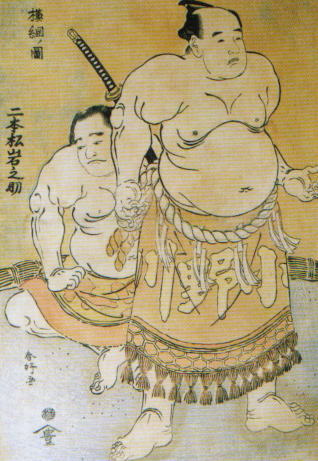
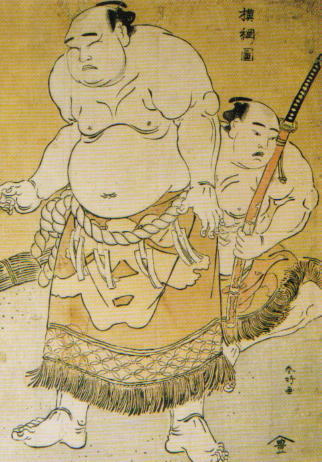
Kisaburo Onogawa Kajinosuke Tanikaze
相撲の歴史英語版
Sumo
History
 and Tagimano-Kuehaya
and Tagimano-Kuehaya . In this match, Sukune kicked Kuehaya down to the earth. Kicking down
is not allowed in contemporary sumo. Although this was totally different
from existing sumo, Sukune, is anyhow, deemed as father of sumo.
. In this match, Sukune kicked Kuehaya down to the earth. Kicking down
is not allowed in contemporary sumo. Although this was totally different
from existing sumo, Sukune, is anyhow, deemed as father of sumo.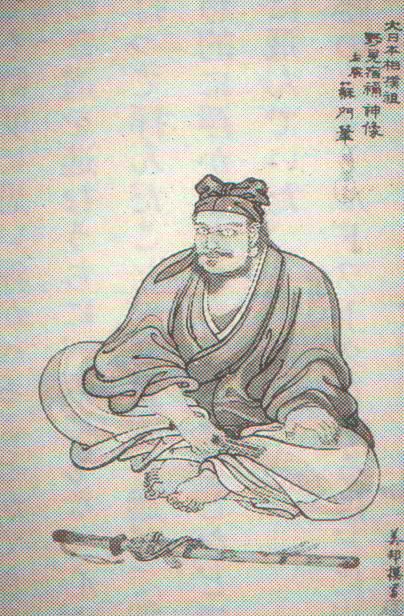 . Furthermore, there are epitaphs and/or five roofed stone towers(built
in early years of Kamakura era) praising Sukune’s achievement at 12 gods
shrines in Sakurai city, Nara and Izumo, Shimane.
. Furthermore, there are epitaphs and/or five roofed stone towers(built
in early years of Kamakura era) praising Sukune’s achievement at 12 gods
shrines in Sakurai city, Nara and Izumo, Shimane. 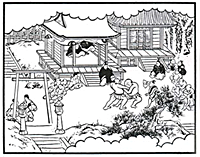
 . This is because a special permission was necessitated from Bakufu (Edo
Shognate Government)even for without- contribution sumo as well as Kanjin
Sumo .
. This is because a special permission was necessitated from Bakufu (Edo
Shognate Government)even for without- contribution sumo as well as Kanjin
Sumo . from a scaffold sounds loudly from early morning and so on. So, impresario
of sumo performance had to obtain a pardon permission from Bakufu to cause
aforementioned inconvenience and noise among neighbors. When they are permitted,
a scaffold is set up for taiko yagura and a notice board called”Gomen-Fuda”
from a scaffold sounds loudly from early morning and so on. So, impresario
of sumo performance had to obtain a pardon permission from Bakufu to cause
aforementioned inconvenience and noise among neighbors. When they are permitted,
a scaffold is set up for taiko yagura and a notice board called”Gomen-Fuda” saying that they obtained a permission
from authority concerned is hoisted with some ceremony. This practice is
succeeded by contemporary ohsumo as well. Immediately after an official
permission is obtained, they make some ceremony called “Gomen-Iwai” inviting
authorities concern such as municipal office, fire department, police,
health office and mass communication and they inform them of schedule etc
of basho(where sumo tournament is held). You can not start preparatory
works such as setup of taiko yagura(drum scaffolding)
saying that they obtained a permission
from authority concerned is hoisted with some ceremony. This practice is
succeeded by contemporary ohsumo as well. Immediately after an official
permission is obtained, they make some ceremony called “Gomen-Iwai” inviting
authorities concern such as municipal office, fire department, police,
health office and mass communication and they inform them of schedule etc
of basho(where sumo tournament is held). You can not start preparatory
works such as setup of taiko yagura(drum scaffolding) ,spectator seat, dohyo construction, advance ticketing and etc until you
finish Gomen Iwai. Thus, sumo is unique sports having a long tradition
and practice. In June of 2nd Shoho(A.D.1645),sumo in presence of imperial
highness was held at Tadamori, Kyoto.*Kokon Sumo Taizen=All Sumo History
Old & Now*
,spectator seat, dohyo construction, advance ticketing and etc until you
finish Gomen Iwai. Thus, sumo is unique sports having a long tradition
and practice. In June of 2nd Shoho(A.D.1645),sumo in presence of imperial
highness was held at Tadamori, Kyoto.*Kokon Sumo Taizen=All Sumo History
Old & Now*  praising past Yokozunas together with
praising past Yokozunas together with 

Kisaburo Onogawa Kajinosuke Tanikaze
In April of 2nd Kaei (A.D.1849), Shogun Joran Sumo by Ieyoshi Tokugawa
was held at Edo Castle.
On June 3 of 6th Kaei (A.D.1853),Perry led a fleet of battleships to Uraga.
This point is a time of change in Japanese history. An Ukiyoe depicts a
sumo wrestler throwing a crew of the fleet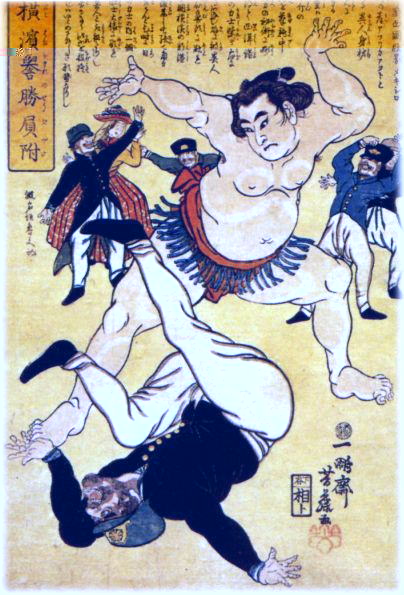 . Cyohsyu (now,Yamaguchi Pref) was defeated at the Kinmon battle and voice
of Kobu-Gattai (alliance of imperial highness and shogunate government
) became stronger than Sonnou-Jooi (revere Imperial highness and reject
foreign invasion) there. In December of 1st Genji(A.D.1864), Shinsaku Takasugi,
in a peril of this trend and in order to repel it, again rose in arms
. Cyohsyu (now,Yamaguchi Pref) was defeated at the Kinmon battle and voice
of Kobu-Gattai (alliance of imperial highness and shogunate government
) became stronger than Sonnou-Jooi (revere Imperial highness and reject
foreign invasion) there. In December of 1st Genji(A.D.1864), Shinsaku Takasugi,
in a peril of this trend and in order to repel it, again rose in arms
at KohzajiTemple with help from a squadron of 30 sumo wrestlers led by
Shunsuke (later; Hirofumi Itoh:the 1st. Prime Minister)
, and 50 fighters led by Kogoro Ishikawa. At a later day, Kiheitai
and other militia also joined this force. In March of 2nd Genji(A.D.1865),
Sonnou Jooi group had consequently won over Kobu Gattai fraction. and they
got a hegemony leading Cyohsyu against Tokugawa Shogunate and won over
them. Ryoma Sakamoto of Kameyama-Shachu also helped Takasugi and others
in this battle and contributed a lot to this win . Ryoma also coordinated
alliance of Cyohsyu and Satsuma(now, Kagoshima Pref.) to fight together
against the Edo government. Reversion of sovereignty from Edo Bakufu to
Imperial Highness. Toba-Fushimi(in Kyoto) Battle. In April 11 of Keio (A.D.1867),Edo
Castle had been surrendered without any resistance.
End of Edo era.
Thus,
feudal lords had bankrupted. Sumo wrestlers who feudal lords employed became
difficult to exist.
After the Meiji Restoration On April 17 of 4th Keio (1st Meiji,A.D.1868),The
Emperor Meiji had been presence at Kyoto sumo held at Zama Shrine,Osaka.
In March of 2nd Meiji(A.D.1869),Osaka sumo abolished their banzuke of horizontally
written of two(East/West) columns and unified to Edo style of vertical written
of one. In June of same year, Daimyo’s domains had been abolished,. Consequently,
their sumo wrestlers were unemployed. In March of 4th Meiji(A.D.1971),
a joint sumo of triple cities(Kyoto, Osaka and Tokyo)had first been held
in Kyoto. In August of same year, Meiji Restoration Government proclaimed
Bobbed Hair Order, but mage(sumo wrestler hair style) became exceptional
from this order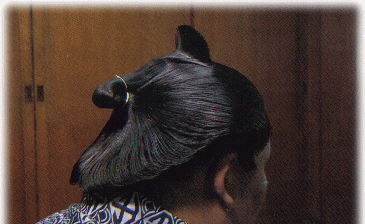 .
.
In January of 21st Meiji(A.D.1889), the letter of Juryo on banzuke sheet
was written a little bolder than before. In January of 22nd Meiji(A.D.1890),
Tokyo sumo had changed the nomination of Sumo Kaisho which had been used
from Edo era to Tokyo Ohkakuteii Kyokai(ozumo kyoukai) . and limited the
number of Toshiyori (retired sumo wrestlers who can stay at the association
after retirement as they own certain amount of the share)to 88. In February
of 42nd Meiji(A.D.1910), Tokyo Ohsumo Association added a stipulation clearly
stating that nomination of Yokozuna should be limited to champion wrestlers
only, not for the highest ranked wrestlers .
In June of same year, Kokugikan( national sumo game pavilion ) was built , so that it could be possible to hold 10 days successive performance without
any cessation regardless of weather. In January of 43rd Meiji(A.D.1911),
both Tokyo and Osaka Ohsumo Association had broken up their relationships
because of Yokzuna problem of Ohkido of Osaka. In November of 1st Taisho(A.D.1912),
both associations had reconciled. In September of 12th Taisho(A.D.1923),
Ryogoku Kokugikan had wholly been burned down by Kanto Mega Earthquake
, so that it could be possible to hold 10 days successive performance without
any cessation regardless of weather. In January of 43rd Meiji(A.D.1911),
both Tokyo and Osaka Ohsumo Association had broken up their relationships
because of Yokzuna problem of Ohkido of Osaka. In November of 1st Taisho(A.D.1912),
both associations had reconciled. In September of 12th Taisho(A.D.1923),
Ryogoku Kokugikan had wholly been burned down by Kanto Mega Earthquake
. In April of 14th Taisho(A.D.1925), sumo performance had been held to
cerebrate the birthday of The Emperor Showa at east court of Akasaka Imperial
Palace, Tokyo. With allowance from The Emperor Taisho, Emperor’s Cup to
be donated
In July of same year, both
Tokyo and Osaka Ohsumo Associations, competing with each other so far, had dissolved themselves
and made a sign to unify both associations into one. Tokyo had proposed Osaka that both ohsumo
could compete with each other for the Emperor’s Cup which had before been given for Tokyo only. Thus,
their face being saved, Osaka had accepted Tokyo’s proposal and agreed to be unified. On December 28,
Ministry of Education/Culture had approved Dai-Nihon Sumo Kyoukai (Great Japan Sumo Wrestling
Association), as a public corporate. In 15th Taisho(A.D. 1926), Tsunenohna, 31st Yokozuna,
won the January basho and got the first Emperor’s Cup. In January of 2nd
Showa(A.D.1927), both Tokyo and Osaka Sumo Associations had officially
unified and named the unified Association as Great Japan Sumo Wrestling
Association. In January of 3rd Showa(A.D.1928), shikiri is regulated to
be lined in the span of 60 cm in between both lines of white at the center
of dohyo. Time limit for shikiri was also set up as being 10 minutes for
makuuchi, 7 minutes for juryo and 5 minutes for makushita. In May of 5th
Showa(A.D.1931), diameter of dohyo is also regulated as 15 shaku (4.95
m), and dually encircled straw bags into one. and the roof of dohyo to
be constructed in Shinmei style. In January of 7th Showa (A.D. 1937), those
sumo wrestlers of Dewanoumi faction ranked in west of banzuke besieged
Shunju-en, Ohoi,Tokyo, appealing to renewal of sumo-do(How should sumo
be). Some wrestlers ranked in east also joined this appeal, retiring from
the association. This caused cancellation of the January sasho. This was
called as Shunju-en Incident. In 12th Showa(A.D.1937), Dai-Kokugikan (national
sumo pavilion) was completed at Sekime, Joto-ward, Osaka and pre -Osaka
basho was held on both days of June 12 & 13. In May of 14th Showa (A.D.1939),
sumo basho of 15 days started.
After Outbreak of Pacific War between Japan and U.S.A. In December of 16th
Showa (A.D.1941), Japan made a sudden attack in Pearl Harbor. The war between
Japan and U.S.A. had begun. Nevertheless, ohsumo had been continued as
follows; Showa(A.D.) Basho Champion Ranking Heya Outcome 16(1941) spring
Futabayama Yokozuna Tatsunami 14-1 summer Haguroyama Ozeki Tatsunami 14-1
17(1942) spring Futabayama Yokozuna Futabayama 14-1 summer Futabayama Yokozuna
Futabayama 13-2 18(1943) spring Futabayama Yokozuna Futabayama 15-0 summer
Futabayama Yokozuna Futabayama 15-0 19(1944) spring Saganohana Komusubi
Nishonoseki 13-2 summer Haguroyama Yokozuna Tatsunami 10-0 autumn Maedayama
Ozeki Takasago 9-1 20(1945) summer Bishuyama 1st Maegashira Isegahama 7-0
autumn Haguroyama Yokozuna Tatsunami 10-0 In 19th Showa(A.D.1944),
Ryogoku
Kokugikan had been taken over by military. And some sumo wrestlers had
been called for a military training. In May of same year, 10 days sumo
when not rainy, was held at Korakuen Stadium. In November, same was done
at same place. In March of 20th Showa(A.D.1945), by US air-strike, Ryogoku
Kokugikan was damaged. In June of same year, 7 days sumo was held at damaged
Kokugikan without any announcement. In August of same year, the war had
ended . In November of 20th Showa(A.D.1945), first postwar hon-basho(regular
tournament of ohsumo) of 10 days was held at the damaged Ryogoku Kokugikan.
In December of same year, US occupation HQ had taken over Kokugikan. In
21st Showa(A.D.1946), hon-basho(summer) had been cancelled since repairmen
of the damaged Kokugikan had largely been delayed. In June o 22nd Showa(A.D.
1947), natsu(summer)-basho of 10 days when not rainy was held at Meiji-Jingu-Gaien.
In November of same year, aki(autumn)-basho of 10 days when not rainy was
held at the same place. 3 awards of most valuable prize, fighting spirit
prize and technically excellent prize were established from this basho.
In May of 23rd Showa(A.D.1948), natsu-basho of 11 days when not rainy was
held at Meiji-Jingu-Gaien. In October of same year, hon-basho of 11 days
was held at Osaka temporary Kokugikan. In January of 24th Showa(A.D.1949),
hon-basho of 13 days was held at Hamacho temporary Kokugikan. In May of
the same year, natsu-basho of 15 days was held at Hamacho temporary Kokugikan.
On October 23 of the same year, Ozeki Chiyonoyama (Dewanoumi ) became champion
at record of 13-2. In January of 25th Showa(1950), 15 days ohsumo was held
at temporary Kokugikan set up at Kuramae, Tokyo. Kuramae where matches
were always heated and people were so excited had repeatedly been repaired
but no roof on it. In January of 60th Showa(A.D.1985),new Kokugikan had
been completed at Ryogoku, Tokyo but in order to keep the atmosphere, roof
had not been set up there. In July of 27th Showa(A.D.1952), rikishi-nobori(sumo
wrestler banner) had been hoisted since 43 years when done at Ekoin, Honjo,
Tokyo of 42nd Meiji(A.D. 1910). In September of the same year, pillars
had been withdrawn from the four corners of dohyo and instead, four colored
tassels were hung from suspended roof . These four colored tassels of blue, red, white and black are such talisman as protecting each of four corner s of dohyo, namely east, south, west and north in order. It also means
four seasons of spring, summer, autumn and winter. In January of 28thShowa(A.D.1953), it was
decided that hon-basho would regularly beheld at 4 throughout the year as spring –basho at Osaka
while summer, autumn and winter at Tokyo.In September of 29th Showa(1954), Kuramae Kokugikan
was completely repaired, and natsu-basho was held there.
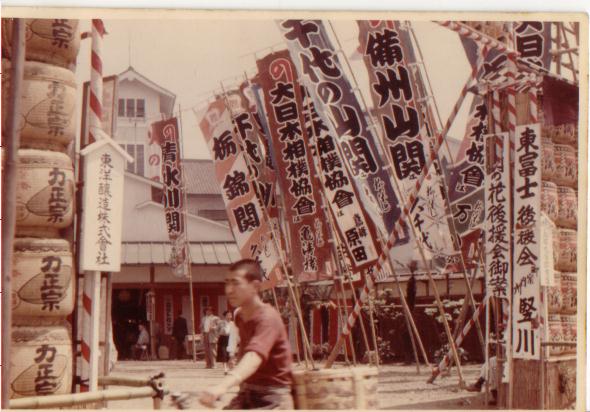
In May of 30th Showa(A.D.1955),
The Emperor Showa had inspected 10th day of natsu-basho held at Kuramae Kokugikan for the first time since end of the Pacific War. And he left tanka( Japanese brief poem) chanting his relief from miserable
war with settlement and recovery and appreciation of being peaceful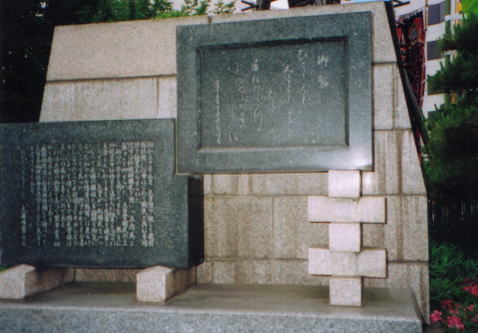
In January of 32nd Showa(A.D.1957), it was decided to add one more sumo tournament in November
at Kyushu to said four basho. Thus, hon –basho became 5. In January of 33rd Showa(A.D.1958),
it was also decided to add one more in July at Nagoya, Thus hon-basho became 6 in total. In January
of the same year, Dai Nihon Sumo Kyokai had been altered to Nihon Sumo Kyokai(Japan Sumo
Wrestling Association). The 2nd chapter of the corporate stipulation says that they intend a healthy
growth of sumo-do and contribute to the public for their physical or spiritual betterment.
In March of the same year, Wakanohana, the 45th Yokozuna ,inaugurated. Since then, a boom
of Tochi (Tochinishiki, powerful Yokozuna opponent of Wakanohana)vs Waka Age had come.
In due course of TV prevailing throughout this country of this age, another good matches such
as Taiho vsKashiwado Age, Kitanoumi vs Takanohana Age, Chiyonofuji hegemony became booming
successively.
In January of 43rd Showa(A.D.1968), Prime Minister Award was newly established.
In May of 45th Showa(A.D.1970), span of both shikiri lines was extended to 70 cm from 60 cm.
On October 4 of 59th Showa(A.D. 1984), Kuramae Kokugikan had been closed.
In January of 60th Showa(A.D.1985), Ryogoku Kokugikan had newly been opened.
In January of 7th Heisei(A.D.1995), Takanohana, the 65th Yokozuna, inaugurated.
In July of 10th Heisei(A.D.1998), Wakanohana, the 66th Yokozuna, inaugurayed.
Waka-Taka age had started. In January of 13th Heisei(A.D.2001), number
of trick was officially limited to 82. Physical check for recruiting sumo
wrestler newly was revised as; 173 m minimum for height and 75 kg minimum
for weight for first pass and for those who could not reach minimum required
in the first pass can get another test of their physical ability if they
are higher than 167 cm and heavier than 67 kg. There was also a revision
in makushita ranking system; according to outcome of amateur sumo, the
can be classified into makushita 10th to 15th grade. In March of 15th Heisei(A.D.2003),
Asashoryu, the 68th Yokozuna, inaugurated. Local sumo tour was changed
from a volunteering of Japan Sumo Wrestling Association to sold-out to
each local impresario. In January of 16th Heisei(A.D.2004), official injury
rule was abolished. Activity of foreign sumo wrestlers became outstanding
in upper ranks. In December of 17th Heisei(A.D.2005), Japan Sumo Wrestling
Association cerebrated the 80th birth since its corporate In 19th Heisei(A.D.2007),
May tournament counted a record high18 foreign sumo wrestlers . In July
of the same year, Nagoya-basho cerebrated 50th birth since its debut. In
September of 20th Heisei(A.D.2008), the Association had first called in
council member from outer circle. In January of 22nd Heisei(A.D.2010),
Asashoryu, Yokozuna fromMongol ,the3rd ranked championship winner of 25
times in sumo history, had to quit himself from ohsumo because of lack
of Yokozuna decency qualification. On October 10th of the same year, Sumainosechie
as a national ceremony of July 7 in presence of then Emperor had reappeared
at Heijokyo site of Nara city when they cerebrated 1300th years since transfer
of their capitol to Heijokyo in Nara. There,10 amateur sumo wrestlers performed
it waiting for the emperor’s judgment for ambiguous match as thought so
in Sumainosechie. In March of 23rd Heisei(A.D.2011), the March tournament
had been cancelled. Cancellation of hon basho is only twice in ohsumo history
. Another one is natsu-basho of 21st Showa for delay of repairmen of bombarded
Kokugikan . In April of the same year, hon-basho of May had been held free
without admission fee as titled as a checking basho of sumo wrestlers technicality.
In July of the same year, ohsumo had been normalized, holding July tournament.
In January of 24th Heisei(A.D.2012), Kitanoumi was elected as 12th director
general of the association.